Palms growing in landscapes or field nurseries are subject to a number of potentially serious nutritional deficiencies. Although peninsular Florida soils range from acid and alkaline sands, muck, and marl to limestone, deficiencies of N, K, Mg, Fe, Mn, and B are common on palms growing in all of these soil types to some degree.
This document describes the most common nutrient deficiencies of palms in Florida landscapes or field nurseries. See ENH1009 for fertilization recommendations for Florida landscapes and field nurseries.
Most palm nutrient deficiencies can be readily diagnosed using visual symptoms alone. However, in many cases, leaf analysis can also be helpful in confirming a diagnosis. Iron and B deficiencies are exceptions, however, as symptoms are often poorly correlated with leaf Fe or B concentrations. When sampling for leaf analysis, select 4 to 6 central leaflets from the youngest fully expanded leaf. Soil analysis is not particularly useful for diagnosing palm nutrient deficiencies, since palm nutrient symptomology often bears little resemblance to soil nutrient profiles. Furthermore, optimum soil nutrient levels have yet to be established for any species of palm.
Nitrogen (N)
Although N is by far the most important limiting element in container production of palms, N deficiency is uncommon on palms growing in native Florida soils. It is common, however, on palms of any species that have recently been transplanted from containers into the ground. Nitrogen deficiency is caused solely by insufficient N in the soil. Symptoms of N deficiency appear first on the oldest leaves as a uniform light green coloration (Figure 1). In Dypsis lutescens the golden color of petioles and leaf bases is also characteristic of N deficiency. As the deficiency progresses, the entire palm canopy except for the spear leaf will become chlorotic, and growth rate will be reduced sharply. Palms can exist with chronic N deficiency for a very long time, with leaf size becoming much smaller and trunks tapering to a point as a result.

Potassium (K)
Potassium deficiency is the most common nutritional disorder of palms, not only in Florida, but throughout the palm-growing world. Symptoms vary among species, but always appear first on the oldest leaves. Older leaflets of some palms such as Dictyosperma album (hurricane palm) are mottled with yellowish spots that are translucent when viewed from below (Figure 2). In other palms such as Dypsis cabadae (cabada palm), Howea spp. (kentia palms), and Roystonea spp. (royal palms), symptoms appear on older leaves as marginal or tip necrosis with little or no yellowish spotting present (Figure 3). The leaflets in Roystonea, Dypsis, and other pinnate-leaved species showing marginal or tip necrosis often appear withered and frizzled.

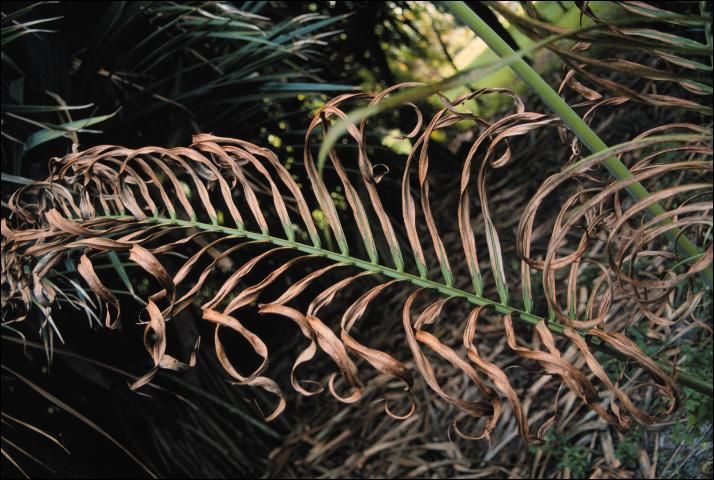
In fan palms such as Livistona chinensis (Chinese fan palm), Corypha spp. (talipot palm), Washingtonia spp. (Washington palms), and Bismarckia nobilis (Bismarck palm), necrosis is not marginal, but is confined largely to tips of the leaflets (Figures 4 and 5). In Phoenix roebelenii (pygmy date palm), the distal parts of the oldest leaves are typically orange with leaflet tips becoming necrotic (Figure 6). The rachis of the leaves usually remains green, however, and the orange and green are not sharply delimited as with Mg deficiency. This pattern of discoloration holds for most palm species that show discoloration as a symptom. In P. canariensis (Canary Island date palm), leaflets show fine (1–2 mm) necrotic or translucent spotting and extensive tip necrosis. These necrotic leaflet tips in most Phoenix spp. are brittle and often break off, leaving the margins of affected leaves irregular.
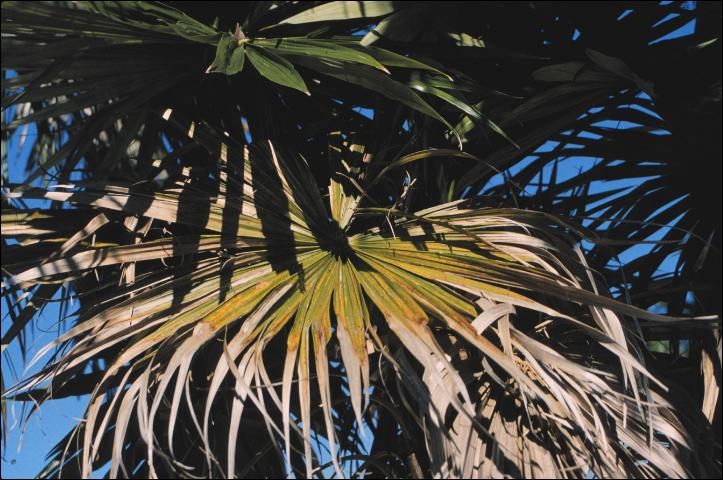

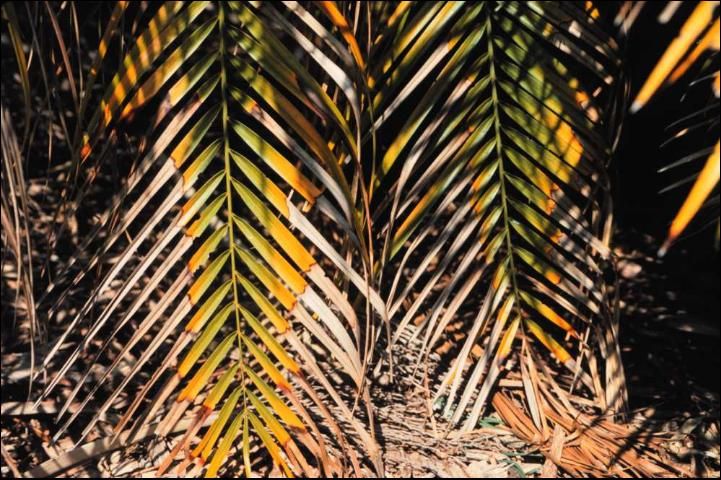
In Caryota spp. and Arenga spp., chlorotic mottling is minimal or non-existent, but early symptoms appear as irregular necrotic spotting within the leaflets (Figures 7 and 8). In most other palms, including Cocos nucifera (coconut palm), Elaeis guineensis (African oil palm), Dypsis lutescens (areca palm), Chamaerops humilis (European fan palm), Hyophorbe verschafeltii (spindle palm), and others, early symptoms appear as translucent yellow or orange spotting on the leaflets and may be accompanied by necrotic spotting as well.
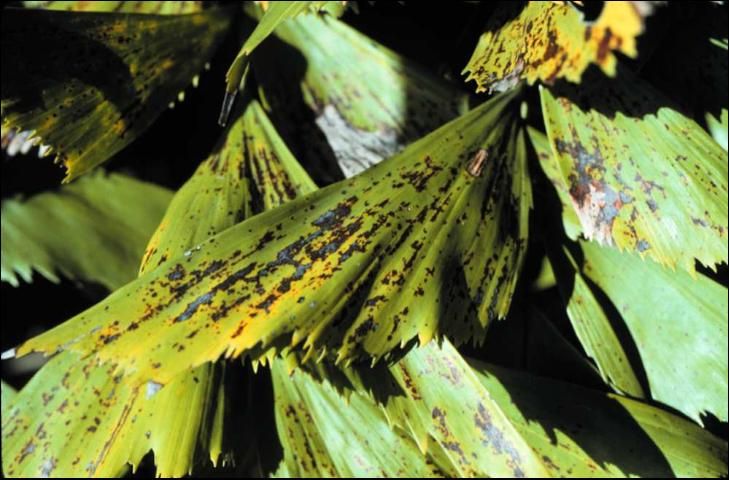
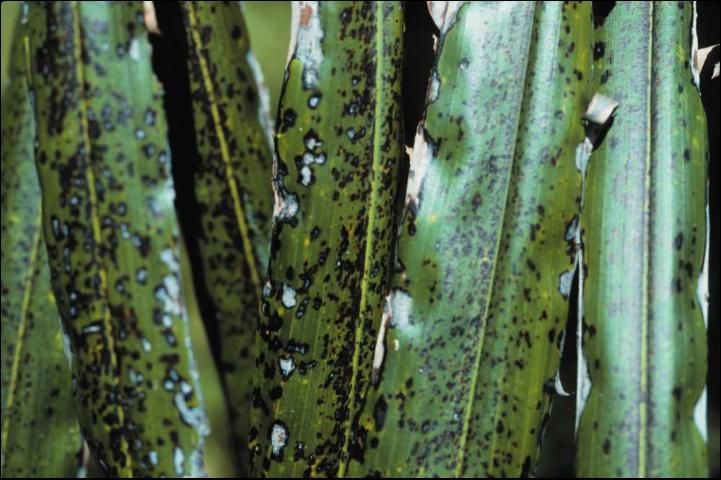
As the deficiency progresses, marginal and tip necrosis will also be present (Figure 9). The most severely affected leaves or leaflets will be completely necrotic and frizzled except for the base of the leaf, leaflet bases, and the rachis. Symptoms decrease in severity from tip to base of a single leaf and from old to new leaves within the canopy (Figures 9 and 10). Because K deficiency causes premature senescence of older palm leaves, the severity of this deficiency is best measured not by the number of discolored and symptomatic leaves, but rather by the number of living leaves in the canopy. In severe cases, the entire canopy will consist of a reduced number of leaves, all of which will be chlorotic, frizzled, and stunted (Figure 11). The trunk will begin to taper (pencil-pointing) and death of the palm often follows.
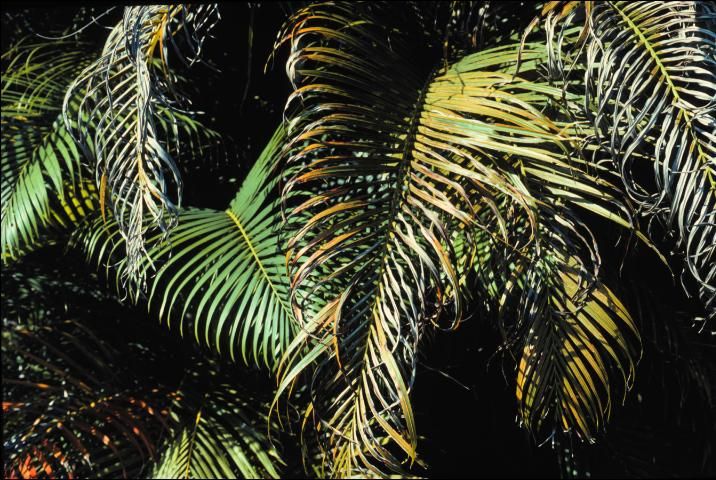


Potassium deficiency is generally caused by insufficient K in the soil, but is exacerbated by high N fertilization. Since most Florida soils have very low cation-exchange capacities, K is readily leached out of the root zone by heavy rainfall or irrigation.
Magnesium (Mg)
Magnesium deficiency is a common deficiency only on Phoenix canariensis growing in Florida landscapes or field nurseries. In most other species of palms, it occurs primarily as a result of improper fertilization. Magnesium deficiency is caused by insufficient Mg in the soil. Magnesium is readily leached from sandy and other soils having little cation-exchange capacity. High levels of N, K, or Ca in the soil can also induce or exacerbate Mg deficiencies.
Symptoms of Mg-deficient palms occur on the oldest leaves as broad chlorotic bands along the margins with the central portion of the leaves remaining distinctly green (Figures 12 and 13). In severe cases, only the rachis and adjacent portions of the leaflets remain green on the oldest leaves, but younger leaves show progressively wider bands of green along the centers of leaves. In Phoenix spp., leaflet tips on the oldest leaves may be necrotic, but this necrosis is due to K deficiency superimposed on Mg-deficient leaves. Where the two deficiencies coexist on the same palm, the oldest leaves will show typical K deficiency symptoms, while Mg deficiency symptoms will be visible on mid-canopy leaves. Transitional leaves will have K deficiency symptoms on the distal portion of the leaf, while Mg chlorosis will be seen on the basal leaflets (Figure 3). In palmate-leaved species with deeply dissected leaves, the chlorosis may appear as broad yellow bands along the margins of individual leaflets (Figure 14). Magnesium deficiency is rarely fatal in palms.
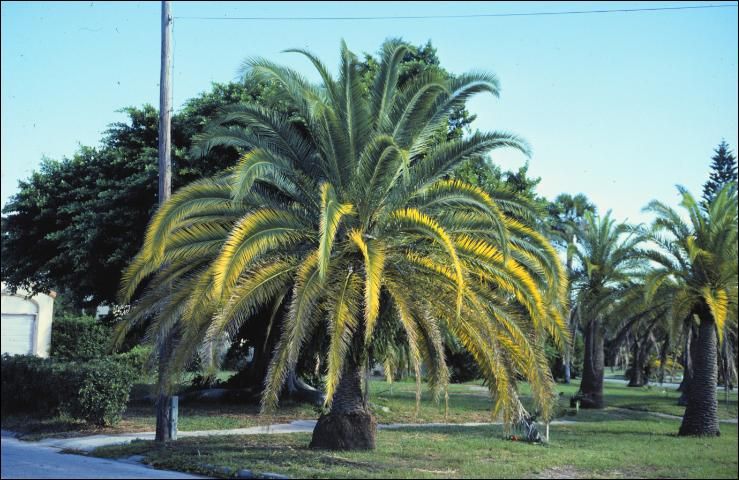

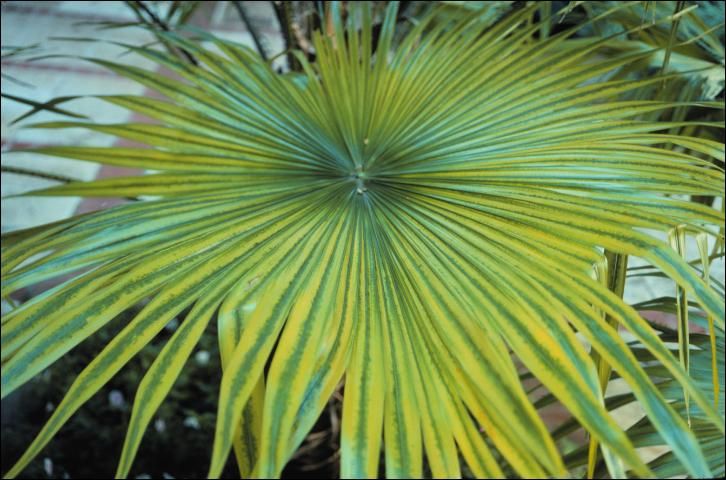
Manganese (Mn)
Manganese deficiency occurs in a wide range of palm species. It is caused by insufficient Mn in the soil or by high soil pH, which greatly reduces Mn availability. In soils where Mn is marginally sufficient, cold soil temperatures may cause temporary Mn deficiency by reducing root activity levels. This is particularly common on Cocos nucifera in Florida. Composted sewage sludge and manure products have also been shown to strongly bind Mn when used as fertilizers or as soil amendments for palms (Figure 21).
Symptoms of Mn deficiency occur on the newest leaves, which emerge chlorotic with longitudinal necrotic streaks (Figures 15 and 16). As the deficiency progresses, newly emerging leaflets appear necrotic and withered on all but basal portions of the leaflets. This withering results in a curling of the leaflets about the rachis giving the leaf a frizzled appearance ("frizzletop") (Figures 17, 18, and 19). Within a single leaf, Mn deficiency symptoms are most severe at the base of the leaf and are less so or nonexistent towards the tip (Figure 20). On new leaves of Mn-deficient Cocos nucifera, necrotic leaflet tips fall off and the leaf has a singed appearance (Figure 21). In severely Mn-deficient palms, growth stops and newly emerging leaves may consist solely of petiole stubs (Figure 22). Death of the meristem usually follows. Although the symptoms described above develop only on newly expanding leaves, the presence of symptomatic leaves lower in the canopy is an indication that Mn deficiency has occurred in the past.
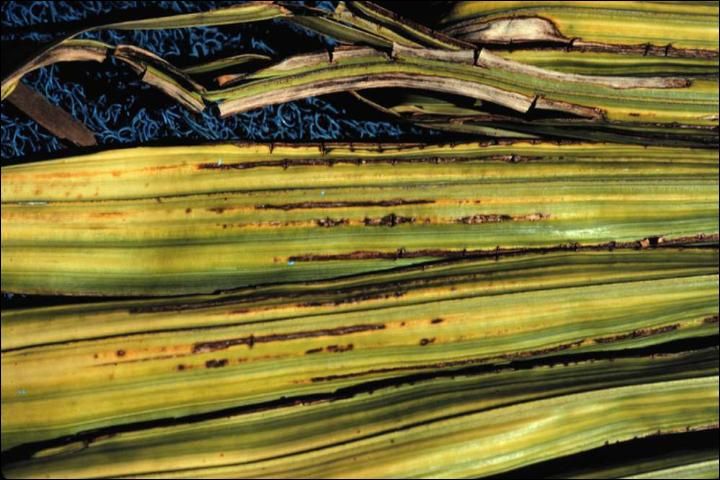
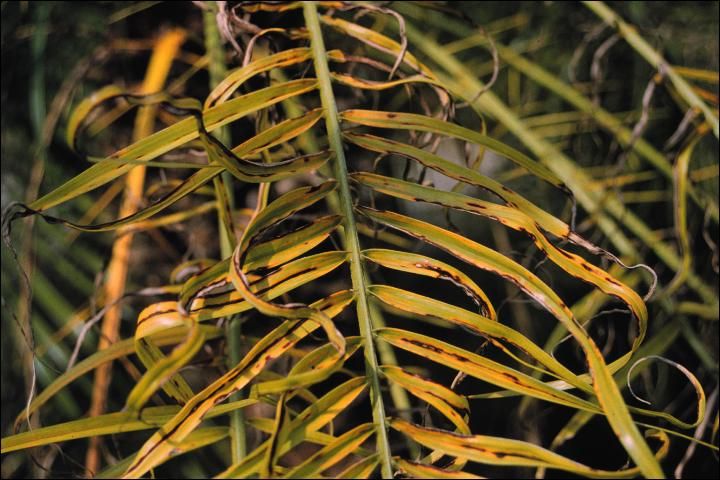
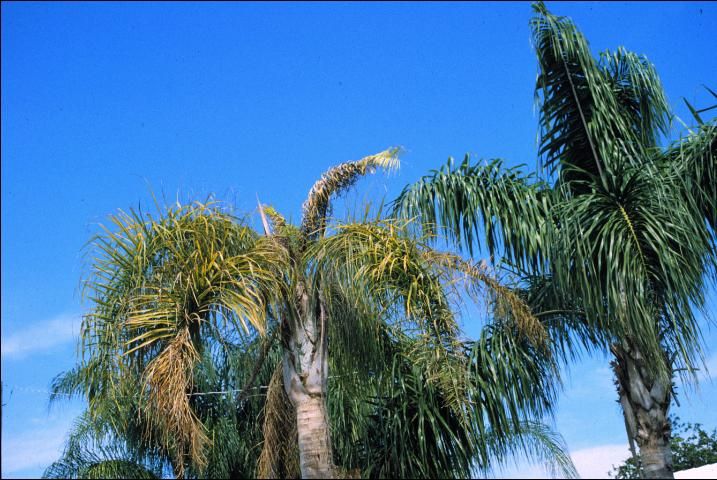
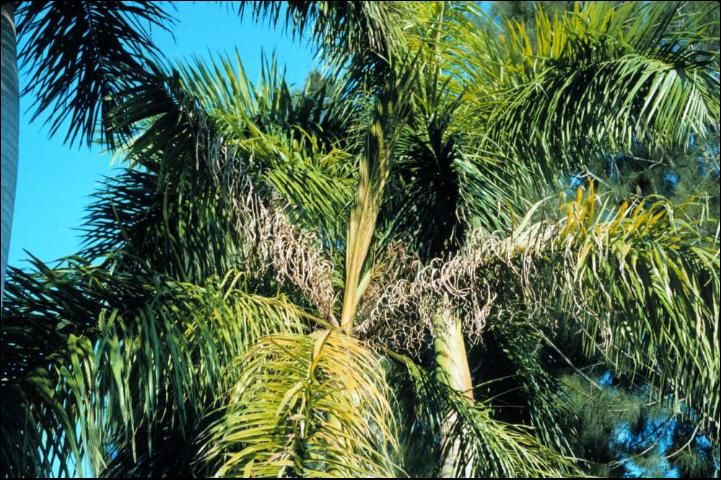
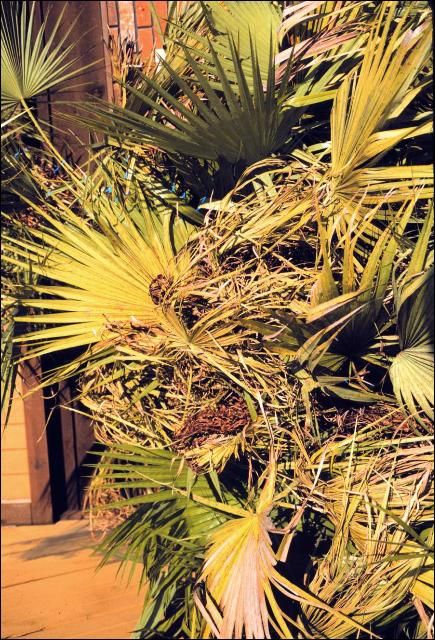
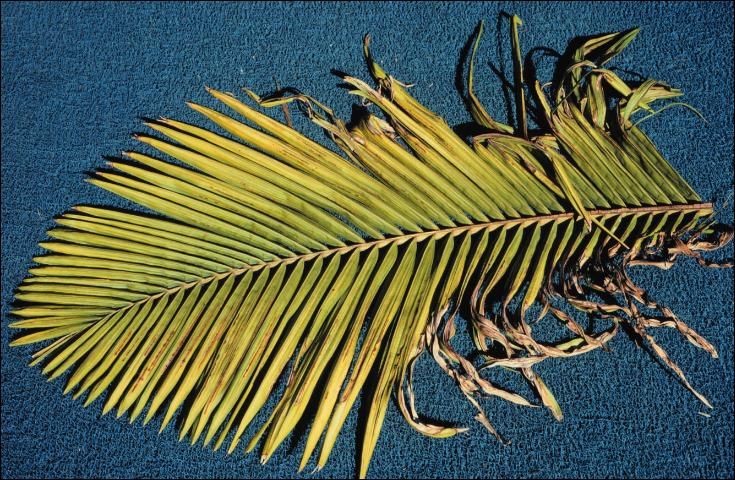

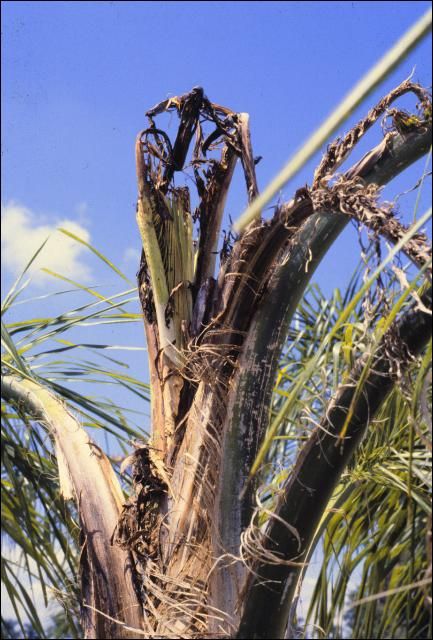
Iron (Fe)
Iron deficiency is not nearly so common on landscape or field-grown palms as it is in broadleaved plants growing in similar sites. Iron deficiency in palms is usually not caused by a lack of Fe in the soil, but rather by factors that reduce root respiration and therefore active uptake of Fe. These factors include poor soil aeration and planting palms too deeply. Root injury from root rots that typically follow root suffocation will similarly be expressed above ground as Fe deficiency, since the root surface area available for interception and uptake of Fe will be greatly reduced in root rotted palms. High soil pH is the most common cause of Fe deficiency in broadleaf trees and shrubs, but in palms it is more likely to result in Mn deficiency. Excessive uptake of other nutrient ions such as ammonium, phosphate, manganese, zinc, copper, and other heavy metals often results in Fe deficiency symptoms being expressed.
Iron deficiency appears as interveinal or uniform chlorosis of the newest leaves (Figure 23). Older leaves remain green. In chronic situations, the entire palm canopy will be uniformly chlorotic. In severely Fe-deficient palms, new leaflets may have necrotic tips, growth will be stunted, and the meristem or bud may eventually die (Figure 24). Early symptoms in Syagrus romanzoffiana (queen palm), Rhapis spp. (lady palms), and some Licuala spp. may appear as chlorotic new leaves covered with green spots about 1/8 inch in diameter (Figure 25).
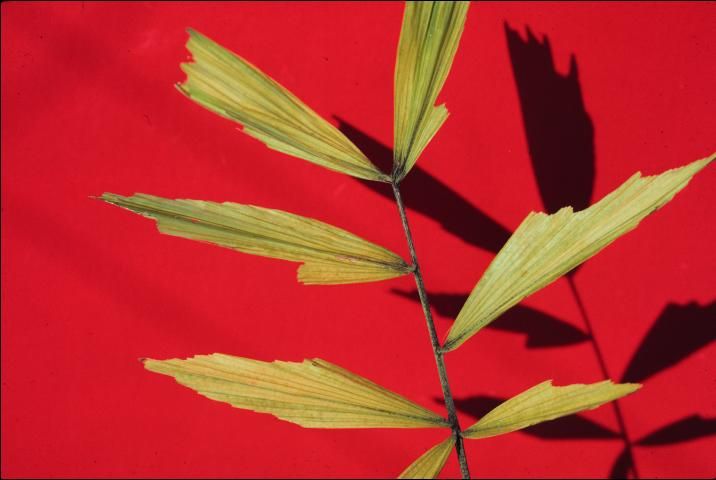
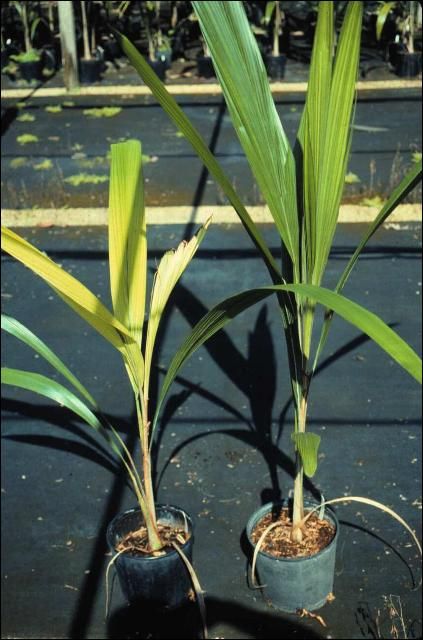
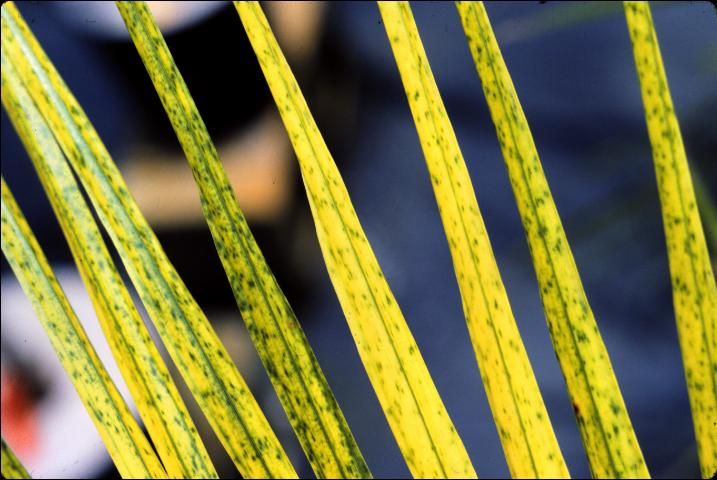
Boron (B)
Boron deficiency has become an increasingly important problem on landscape and field-grown palms in recent years. Boron deficiency is caused by insufficient B in the soil. Boron is readily leached through most soils, with a single heavy rain event temporarily leaching most available B out of the root zone. When this leaching stops, B released from decomposing organic matter will again provide adequate B for normal palm growth in most cases. Boron deficiency is also common in deserts and seasonally dry areas where soil drying tightly binds B. Chronic B deficiency is believed to be caused by soil drying and high soil pH, while temporary B deficiency is caused by heavy leaching.
Boron deficiency causes a wide array of symptoms, not only among species of palms, but also within a single species. Symptoms always occur on newly emerging leaves, but remain visible on these leaves as they mature and are replaced by younger leaves.
One of the earliest symptoms of B deficiency on Dypsis lutescens and Syagrus romanzoffiana is transverse translucent streaking on the leaflets. In many species including Cocos nucifera, Elaeis guineensis, and S. romanzoffiana, mild B deficiency is manifested as sharply bent leaflet tips, commonly called "hookleaf" (Figure 26). These sharp leaflet hooks are quire rigid and cannot be straightened out without tearing the leaflets.
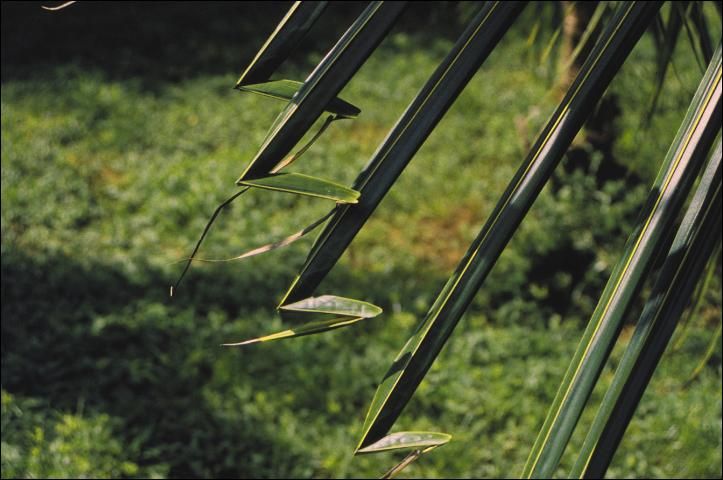
Boron deficiency can be very transient in nature, often affecting a developing leaf primordium for a very short period of time (e.g., 1 to 2 days). This temporary shortage of B can cause necrosis on the primordial spear leaf for a distance of about 1 to 2 cm. When such leaves eventually expand, this "point" necrosis affects the tips of all leaflets intersected by that necrotic point, the net result being the appearance of a blunt, triangular truncation of the leaf tip (Figure 27). This pattern can be repeated several times during the development of a single leaf of Cocos nucifera (about 5 weeks) (Figure 28). Similar patterns have been observed in fan palms (Figure 29).
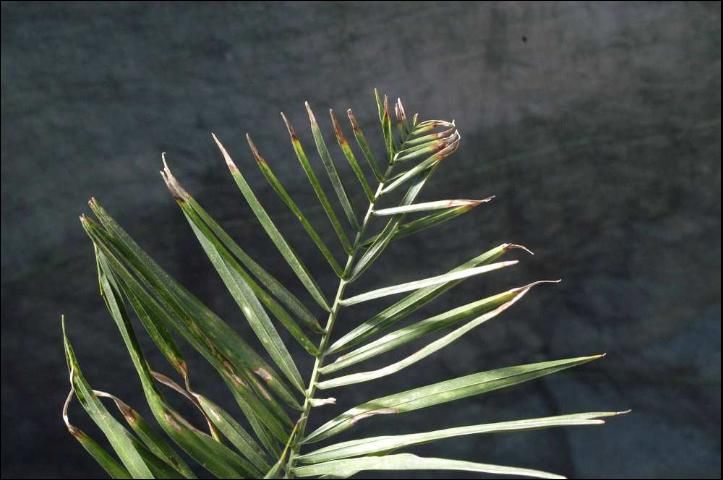
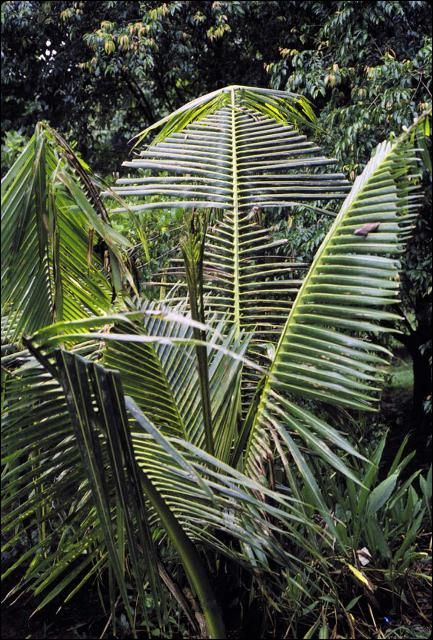
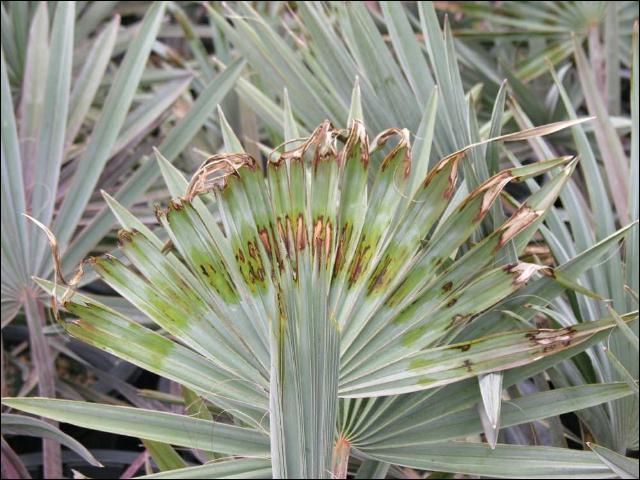
One of the most common symptoms of B deficiency is the failure of newly emerging spear leaves to open normally. They may be tightly fused throughout their entire length, or the fusion can be limited to basal or distal parts of the spear leaf. In a chronic state, multiple unopened spear leaves may be visible at the apex of the canopy (Figures 30 and 31).
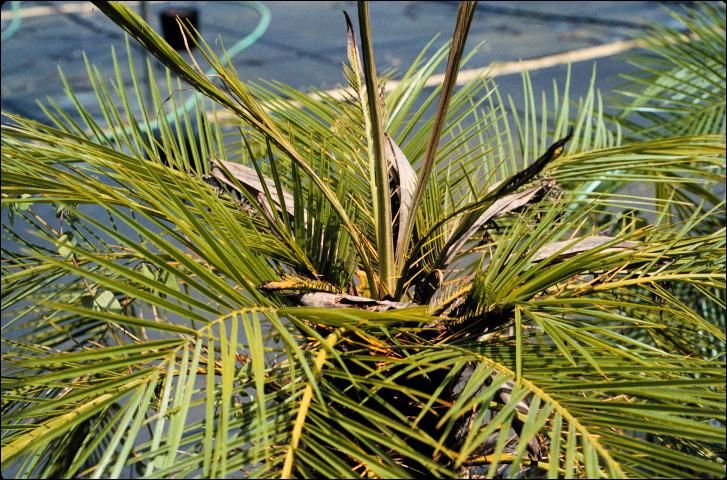
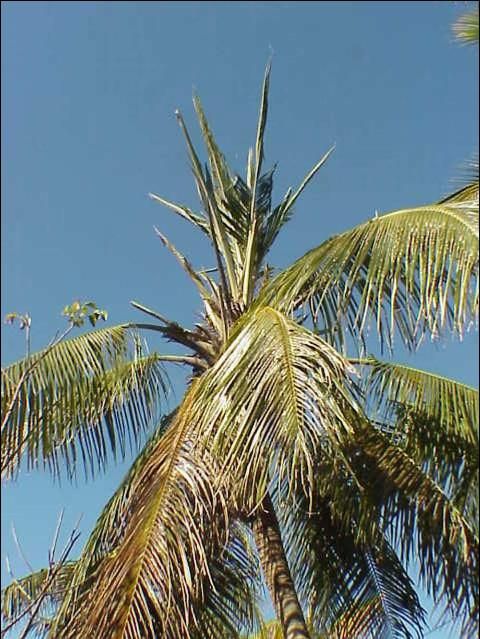
Perhaps the most unusual symptoms of chronic B deficiency is the tendency for the entire crown to bend in one direction (Figure 32). This is one form of epinasty that can also cause twisting of petioles and leaves or sharp bends in the petiole, resulting in a new leaf growing downward along the trunk (Figures 33 and 34). These epinastic symptoms are believed to be caused by a B deficiency-induced decrease in IAA oxidase activity and therefore excessive auxin concentrations within the leaves.
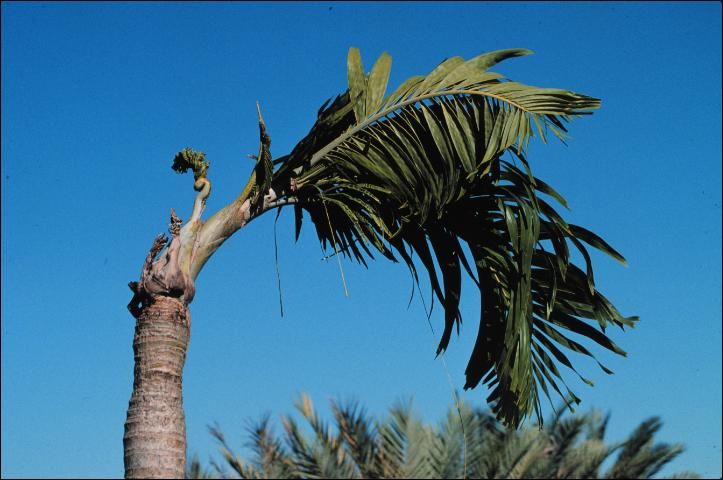
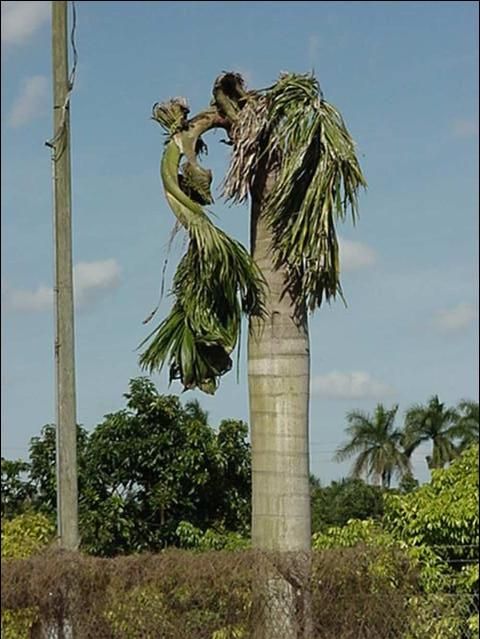
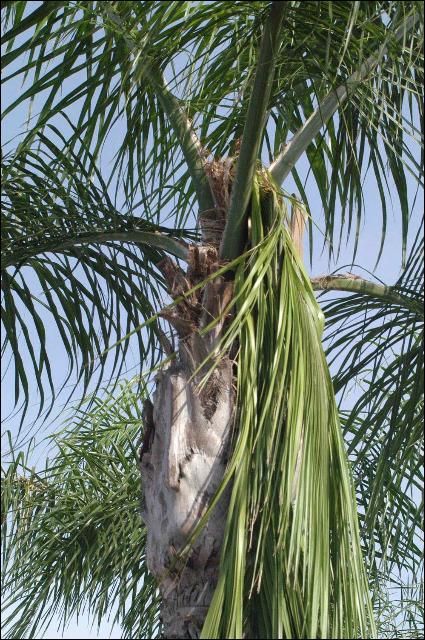
Boron deficiency in its acute form produces yet other symptoms. Often leaves emerge greatly reduced in size and crumpled in a corrugated fashion (accordion leaf) (Figures 35 and 36). Palms may grow out of these symptoms or the deficiency can kill the palm.
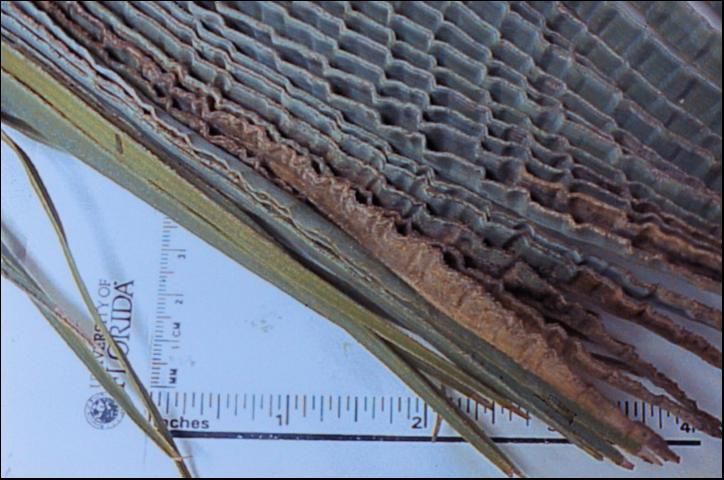
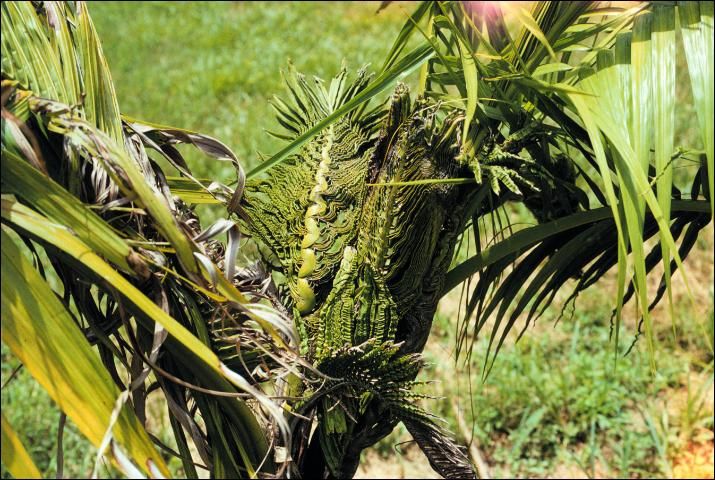
Boron-deficient palms often abort their fruits prematurely and inflorescences (flowers) may have extensive necrosis near their tips (Figures 37 and 38). These symptoms are very similar to those of lethal yellowing (LY) in species affected by that disease. The calyx end of fallen coconuts from LY-infected Cocos nucifera will be blackened, whereas coconuts from B-deficient trees will not have this blackened end.

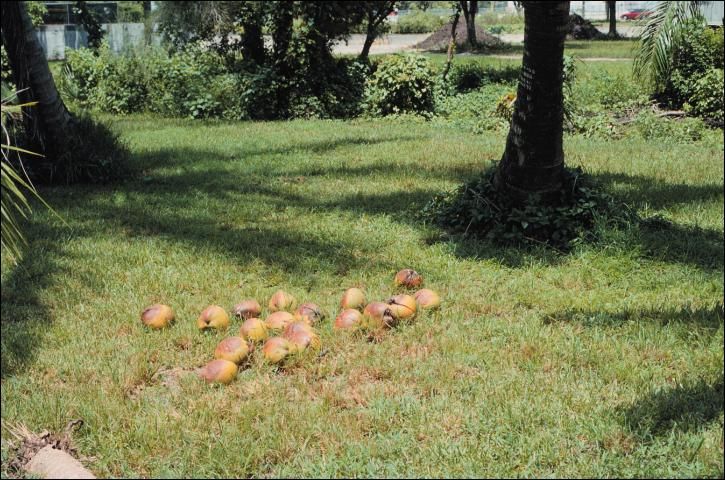
Selected References
Broschat, T.K. 1984. Nutrient deficiency symptoms in five species of palms grown as foliage plants. Principes 28:6–14.
Broschat, T.K. 1990. Potassium deficiency of palms in south Florida. Principes 34:151–155.
Broschat, T.K. 1991. Manganese binding by municipal waste composts used as potting media. J. Environ. Hort. 9:97–100. https://doi.org/10.24266/0738-2898-9.2.97
Broschat, T.K. 1994. Removing potassium deficient leaves accelerates rate of decline in pygmy date palms. HortScience 29:823. https://doi.org/10.21273/HORTSCI.29.7.823
Broschat, T.K. Boron deficiency symptoms of palms. Palms 51:115–126.
Broschat, T.K. Boron deficiency, phenoxy herbicides, stem bending, and branching in palms—is there a connection? Palms 51:161–163.
Broschat, T.K. and H. Donselman. 1985. Causes of palm nutritional disorders. Proc. Fla. St. Hort. Soc. 98:101–102.
Bull, R.A. 1961. Studies on the deficiency symptoms of the oil palm. 2. Macronutrient deficiency symptoms in oil palm seedlings grown in sand culture. J. West African Inst. Oil Palm Res. 3:254–264.
Bull, R.A. 1961. Studies on the deficiency diseases of the oil palm. 3. Micronutrient deficiency symptoms in oil palm seedlings grown in sand culture. J. West African Inst. Oil Palm Res. 3:265–272.
Manciot, E., M. Ollagnier, and R. Ochs. 1979-80. Mineral nutrition of the coconut around the world. Oléagineux 34:511–515; 576-580; 35:23–27.
Marlatt, R. B. 1978. Boron deficiency and toxicity symptoms in Ficus elastica and Chrysalidocarpus lutescens. HortScience 13:442–443. https://doi.org/10.21273/HORTSCI.13.4.442